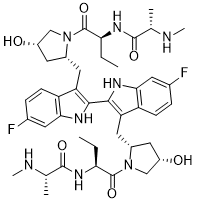| Cas No.: | 1260251-31-7 |
| Chemical Name: | Birinapant |
| Synonyms: | (2S)-N-[(2S)-1-[(2R,4S)-2-[[6-fluoro-2-[6-fluoro-3-[[(2R,4S)-4-hydroxy-1-[(2S)-2-[[(2S)-2-(methylamino)propanoyl]amino]butanoyl]pyrrolidin-2-yl]methyl]-1H-indol-2-yl]-1H-indol-3-yl]methyl]-4-hydroxypy;Birinapant;TL32711;TL-32711;(2S,2'S)-N,N'-[(6,6'-Difluoro[2,2'-bi-1H-indole]-3,3'-diyl)bis[methylene[(2R,4S)-4-hydroxy-2,1-pyrrolidinediyl][(1S)-1-ethyl-2-oxo-2,1-ethanediyl]]]bis[2-(methylamino)-propanamide;Birinapant (TL32711);TL 32711;6O4Z07B57R;(2S)-N-[(2S)-1-[(2R,4S)-2-[[6-fluoro-2-[6-fluoro-3-[[(2R,4S)-4-hydroxy-1-[(2S)-2-[[(2S)-2-(methylamino)propanoyl]amino]butanoyl]pyrrolidin-2-yl]methyl]-1H-indol-2-yl]-1H-indol-3-yl]methyl]-4-hydroxypyrrolidin-1-yl]-1-oxobutan-2-yl]-2-(methylamino)propanamide;(2s,2's)-N,N'-[(6,6'-Difluoro-1h,1'h-2,2'-Biindole-3,3'-Diyl)bis{methanediyl[(2r,4s)-4-Hydroxypyrrolidine-2,1-Diyl][(2s)-1-Oxobutane-1,2-Diyl]} |
| SMILES: | FC1C([H])=C([H])C2=C(C=1[H])N([H])C(C1=C(C3C([H])=C([H])C(=C([H])C=3N1[H])F)C([H])([H])[C@]1([H])C([H])([H])[C@@]([H])(C([H])([H])N1C([C@]([H])(C([H])([H])C([H])([H])[H])N([H])C([C@]([H])(C([H])([H])[H])N([H])C([H])([H])[H])=O)=O)O[H])=C2C([H])([H])[C@]1( |
| Formula: | C42H56F2N8O6 |
| M.Wt: | 806.9409 |
| Purity: | >98% |
| Sotrage: | 2 years -20°C Powder, 2 weeks 4°C in DMSO, 6 months -80°C in DMSO |
| Description: | Birinapant, a bivalent Smac mimetic, is a potent antagonist for XIAP and cIAP1 with Kds of 45 nM and less than 1 nM, respectively. |
| In Vivo: | Birinapant can inhibit tumor growth in melanoma xenotransplantation models. Staining for activated caspase-3 in biopsies of the same tumors show a modest increase in apoptotic cells in the birinapant treated animals[2]. Birinapant (15 mg/kg, i.p.) induces apoptosis in HCT116 tumor-bearing mouse[3]. |
| In Vitro: | Birinapant causes significant degradation of cIAP1 and 2. Birinapant + TRAIL-treated cells show increased levels of active caspase-8 and caspase-3, as well as PARP cleavage, over single agents within 4 h of treatment, indicative of apoptosis-mediated cell death. Birinapan significantly decreases the viability of SUM190 cells in a dose-dependent manner. Birinapant treatment in the XIAP knockdown cell line (SUM190 shXIAP) causes an overall reduction in viability at lower doses (30-300 nM)[1]. Birinapant causes apoptosis in the sensitive cells. Birinapant in conbination with TNF-α, causes PARP cleavage in 451Lu and WM1366 cell lines[2]. Birinapant induces time-course of caspase-3 activation in HCT116 human colon carcinoma and MDA-MB-231 human breast adenocarcinoma cells[3]. |






















